B.E. Smith Team | October 02, 2017
HR’s Changing Role in Focus at ASHHRA 2017
The theme of this year’s American Society for Healthcare Human Resources Administration (ASHHRA) conference, “the changing role of healthcare human resources,” permeated the many illuminating sessions. Healthcare executives and thought leaders highlighted the strategic, tactical, and technological transformation which is currently underway and influencing the role of HR leaders. This B.E. Smith executive brief examines five key themes and actionable insights which garnered much attention at this year’s conference.
Strategic Role of HR in Hospital M&A
 Human Resources is being asked to play a greater role in organizational transformation. One high-profile area of attention at ASHHRA was hospital mergers. Industry consolidation is accelerating: 61% of organizations anticipate an increase in merger, acquisition, and partnership activity over the next three years. (1)
Human Resources is being asked to play a greater role in organizational transformation. One high-profile area of attention at ASHHRA was hospital mergers. Industry consolidation is accelerating: 61% of organizations anticipate an increase in merger, acquisition, and partnership activity over the next three years. (1)
In “The Critical HR Role in Mergers, Acquisitions, and Other Combinations,” Katie Bata, Vice President of Human Resources at Advocate Illinois Medical Center, Scott Gilbert and William Sweeney of Polsinelli PLC, and Edward Rathman, Vice President of Benefits at Catholic Health Initiatives, asserted that HR is a strategic player throughout the transaction process. During due diligence, HR must assess an array of workforce, labor relations, benefits, and compensation issues, identifying questionable practices up front and anticipating what the other party wants to know. Post-transaction, integration of the two organizations is crucial. The speakers counselled HR to begin integration planning before the transaction closes. Specific takeaways:
- Implement well-planned integration quickly
- Align organizational roles/responsibilities
- Communicate new expectations clearly and honestly
- Plan for resistance
Effective M&A management was also the focus of the session “How to Make an Acquisition Feel Like a Merger,” by Martin Everhart, Chief Human Resources Officer at RWJBarnabas Health and Anastasia Jacobs, Vice President of Human Resources at Robert Wood Johnson Hospital (RWJ). They briefly chronicled the combination of RWJ and Barnabas, a “totally new concept to both organizations.” The culture shock created a challenge to successful integration. Human Resources established a “transition pod team” with four focal points: human capital management, employment/orientation, compensation, and culture. The latter received particular emphasis given the strong desire to achieve “values integration and adoption.” The team mapped the values of each institution and sought to adopt the best of both, fostering inclusion to “build buy-in.” One important consideration noted by the speakers, avoid a lengthy time frame for all to accept the new values structure.
Workforce Development Central to Value-Based Care Transition
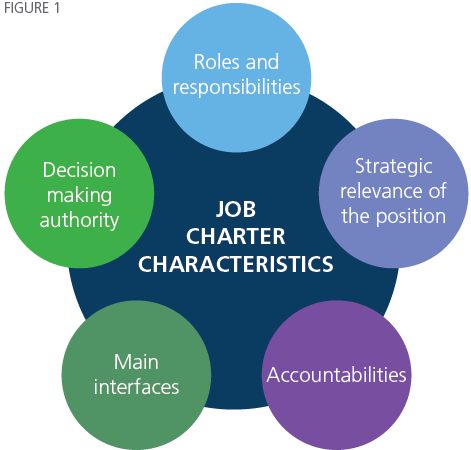 Achieving value-based care is imperative. HR continues to adapt to help fulfill this strategic mission. In the session “Realigning Leadership Roles and Accountabilities to Support a Value-Based Model,” Kimberly White, Vice President at Numerof & Associates and Dr. Jeff Thompson, CEO Emeritus at Gundersen Health, offered the concept of a “structural role realignment process.” It is designed to meet the demands of economic and clinical value and counteract the tendency of organizations to “focus less on employee engagement and more on managing their immediate response to the external environment.” Yet value demands “building organizational capability to manage variation in cost and quality.” Gundersen recognized two key gaps, new competencies were required and leaders needed help understanding how to achieve major objectives.
Achieving value-based care is imperative. HR continues to adapt to help fulfill this strategic mission. In the session “Realigning Leadership Roles and Accountabilities to Support a Value-Based Model,” Kimberly White, Vice President at Numerof & Associates and Dr. Jeff Thompson, CEO Emeritus at Gundersen Health, offered the concept of a “structural role realignment process.” It is designed to meet the demands of economic and clinical value and counteract the tendency of organizations to “focus less on employee engagement and more on managing their immediate response to the external environment.” Yet value demands “building organizational capability to manage variation in cost and quality.” Gundersen recognized two key gaps, new competencies were required and leaders needed help understanding how to achieve major objectives.
In Figure 1, the realignment process centered on establishing “Job Charters” for key positions. The rigorously developed charters provided a roadmap to guide HR in everything from hiring to training to performance management.
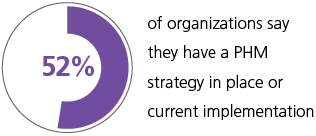 One of value-based care’s showcase strategies is population health management (PHM). B.E. Smith’s annual leadership survey found 52% of organizations say they have a PHM strategy in place or current implementation. HR is at the forefront of nurturing new roles to meet PHM demands, as explored in the session “Defining Success for Critical Population Health Roles,” by Daniel Liss, Project Manager at Mt. Sinai Health, and Michael Ganeles, Practice Leader at Development Dimensions International (DDI).
One of value-based care’s showcase strategies is population health management (PHM). B.E. Smith’s annual leadership survey found 52% of organizations say they have a PHM strategy in place or current implementation. HR is at the forefront of nurturing new roles to meet PHM demands, as explored in the session “Defining Success for Critical Population Health Roles,” by Daniel Liss, Project Manager at Mt. Sinai Health, and Michael Ganeles, Practice Leader at Development Dimensions International (DDI).
Mt. Sinai has committed heavily to PHM, embodied in its advertising slogan: “If our beds are filled, it means we’ve failed.” This necessitates a “workforce enabled for success in population health.” HR successfully zeroed in on care management professionals, from coordinators to patient navigators to senior executives who must:
- Engage challenging patients
- Build clinical and community partnerships
- Manage heavy caseloads
- Drive behavioral change
Specific competencies and personal attributes were detailed for each role, a self-assessment tool was created to help identify internal candidates, and a “value-base care training” curriculum was instituted featuring courses such as “Understanding Behavioral Health” and “Identifying Patient Barriers.”
Drive Leadership Development
Leadership development is central to most HR departments’ missions. Indeed, B.E. Smith’s research found that 55% intend to rely on internal development to groom new and existing leaders. For this reason, it is not surprising the topic received much attention at ASHHRA. Natasha Bowman, former Senior Director at White Plains Hospital used the session “Defining the Hierarchy of Leadership Development” to provide insight on why organizations frequently promote executives without good preparation for new and demanding roles. Bowman cited common barriers:
- No succession planning
- Not anticipating need to fill a leadership position
- Lack of transparency about promotion pathways
- Urgent goals that compete with leadership development
- Lack of resources
She cautioned HR not to turn to “cookie cutter” programs that rarely work because the programs do not adapt to shifting healthcare requirements, “fail to leverage talent effectively,” and contribute to employee disengagement.
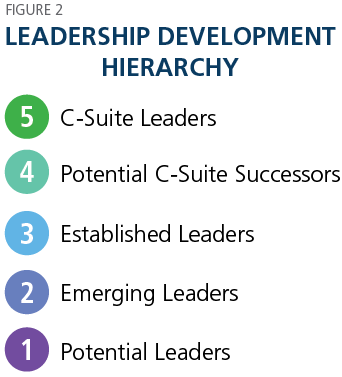 Bowman recommended customization by categorizing potential leaders according to a Leadership Development Hierarchy, displayed in Figure 2. For each level, determine the organization’s unique role requirements and skills. Then devise multifaceted developmental programs that fit these demands. Among other tools, consider assignments that “push the leader out of his/her comfort zone” and courses that “solidify them as subject matter experts for their functions.”
Bowman recommended customization by categorizing potential leaders according to a Leadership Development Hierarchy, displayed in Figure 2. For each level, determine the organization’s unique role requirements and skills. Then devise multifaceted developmental programs that fit these demands. Among other tools, consider assignments that “push the leader out of his/her comfort zone” and courses that “solidify them as subject matter experts for their functions.”
Clinical leadership is crucial to successful value-based care and has spawned a growing need for physician leadership development. Advice on this topic was offered by Dr. Steve Merahn, Chief Medical Officer at Centria Healthcare and Lynne Kornblatt, Chief Human Resources Officer at Fred Hutchinson Cancer Center in the session “From Playing to Conducting: Supporting Physician Transition to Leadership.” Using the orchestra metaphor, the speakers asserted that physicians tend to “want to conduct and sit first chair at the same time,” and encounter difficulties when they believe their role “transcends the enterprise.” HR needs to understand and respect doctors’ cognitive approaches while transitioning them to executive leadership. The framework offered for physician development is shown in Figure 3, enumerating key differences between clinical and executive leadership requirements across five dimensions.
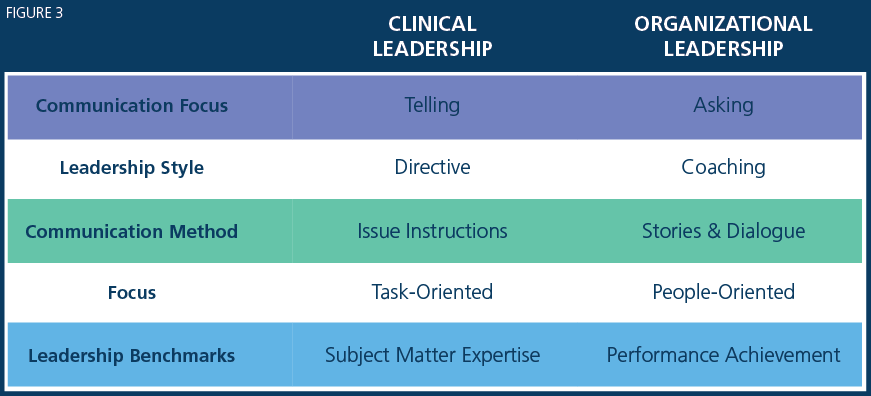
Dr. Merahn and Kornblatt highlighted their successes developing six-week emerging physician leader rotations which exposed physician leaders to a broad range of departments, including housekeeping, procurement, and finance, to reinforce the need to build organizational leadership skills.
Pursue Succession Planning
Succession planning is an area of great opportunity for the healthcare industry. B.E. Smith surveys show that 50% of organizations have no formal program in place. For organizations who want to advance programs, good advice was provided by Lillian LeBlanc, Executive Leadership Development Coach at Baptist South Florida in the session “Leadership Success through Succession Planning.” She observed that frequently “succession planning and talent development are not linked.” The first step in connecting these components is to identify and “calibrate the talent.” LeBlanc presented an easy-to-use grid (see Figure 4) which permits segmentation of succession candidates along two major dimensions: promotability and performance. The typical distribution of successor levels was also provided as guidance.
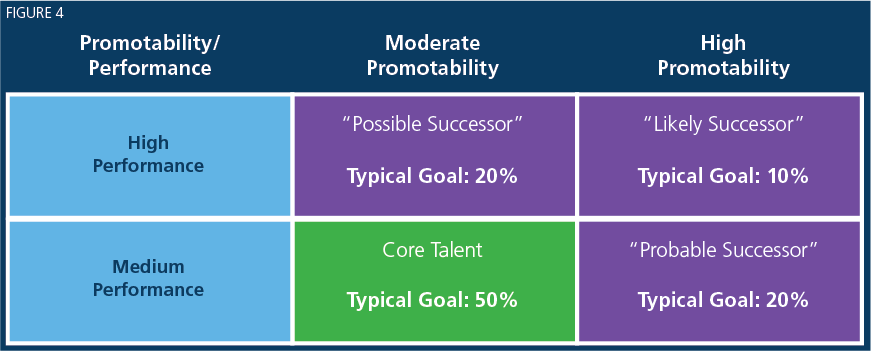
A recurrent theme at ASHHRA was the desirability of customizing efforts to one’s organization rather than using one-size-fits-all programs. LeBlanc suggested mapping appropriate talent development actions to the various grid levels and then to individuals. The ultimate objective should be a succession plan for each promotable. Proven results include greater employee engagement and, crucially for HR, a way to measure the return on succession planning.
Embrace Technology
HR is not immune to the technology transformation sweeping across most professions. In the session “Don’t Fear Tech-Led Automation!,” Meghan Musbach, Healthcare Director at CareerBuilder, presented evidence on the impact of technology. For example, in one CareerBuilder survey 55% of managers believe “artificial intelligence will become a regular part of HR within the next five years.” Automation of many functions can drive real productivity. Respondents estimated average loss of 14 hours per week performing manual tasks that could be automated. Opportunities abound to apply algorithm-based tools to streamline and improve human capital management. Executives reported they are not using technology to help automate the following functions:
- Recruiting – 34%
- Onboarding – 44%
- Employee HR Activities – 60%
Focusing on recruiting, Musbach detailed ways technology is helping devise job descriptions, provide deeper evaluation of candidates, and align expectations between hiring managers and recruiters. She ended by addressing the audience’s ultimate fear, research suggests that the role of HR manager or director is one of the least likely jobs to be automated!
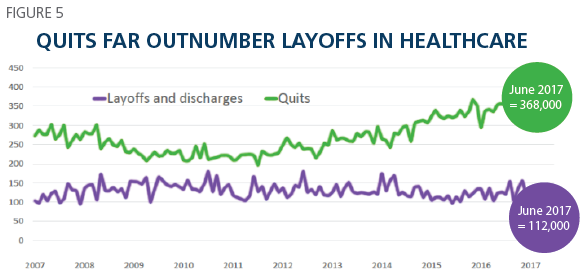
Analytics was also a subject of the session “Leveraging Big Data for a More Productive Workforce.” Amar Mann, Branch Chief at U.S. Bureau of Labor Statistics, catalogued numerous BLS data sets that can be leveraged to beneficial effect in HR. He illustrated the point by assessing retention as an antidote to labor shortages (1.1 million RN job openings by 2024) and job growth forecasts (16.4% more healthcare practitioners needed by 2024). He presented the chart shown in Figure 5 revealing that the rate at which employees quit significantly exceeds that from layoffs – and the gap is widening. Further analysis shows linkage between quits and two causal factors that can be addressed to promote retention:
- Employees able to change jobs within the organization were significantly less likely to quit than those feeling blocked.
- Department size matters. Departments with spans of control exceeding 80 people exhibited higher rates of termination, often more than double the organization’s average rate.
The speaker closed with a call for quality: “Better data equals better decisions.”
Conclusion
From advancing strategic directions to refining leadership development to embracing technology, HR faces many changes and has a full plate. Fortunately, ASHHRA offered timely perspectives to guide leaders to success.
Resources
- HealthLeaders Media, The Steady March of Strategic Partnerships, April 2017.
Read More